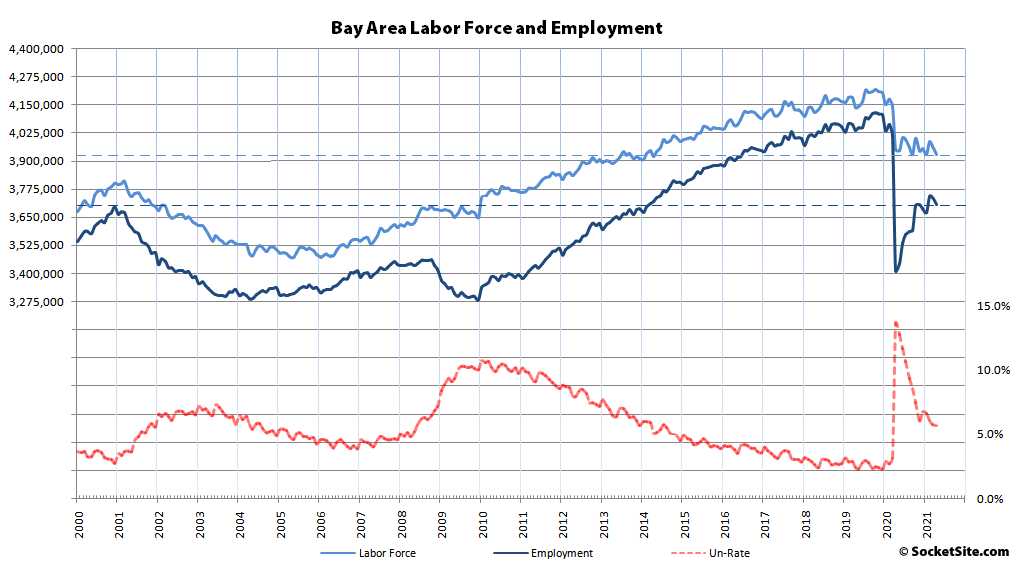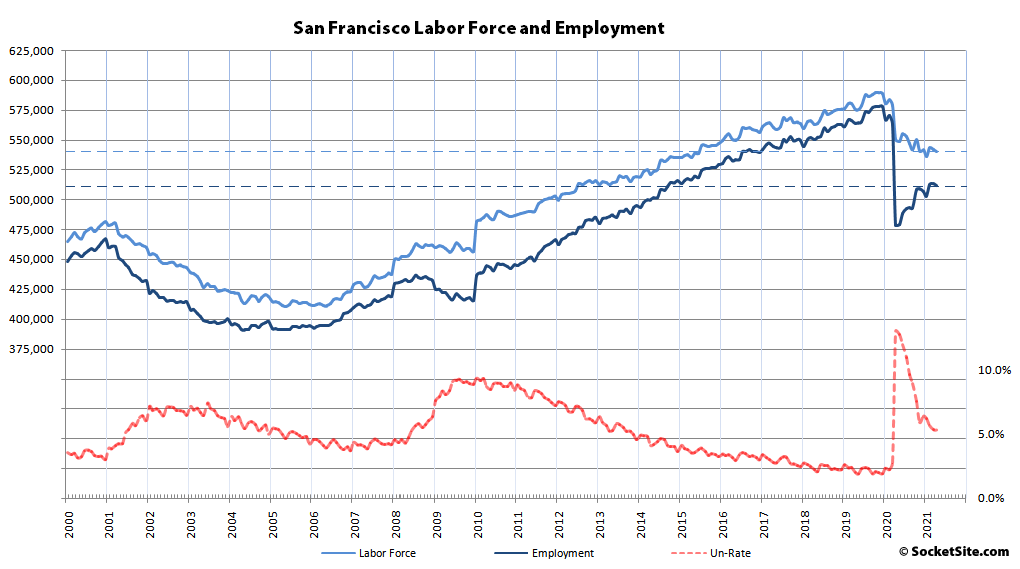While the State’s Stay Home Order were lifted in January and local restrictions on indoor dining, gyms, museums and other indoor attractions were relaxed in early March, with bars having since been allowed to reopen as well, the number of people living in San Francisco with a paycheck actually inched down by 1,700 in April to 511,600.
And while there are now 32,900 more employed residents in San Francisco than there were at the same time last year, there are still 59,200 fewer employed residents in the city than there were prior to the pandemic and the labor force is down by 43,400,for an unemployment rate of 5.3 percent (versus 2.8 percent prior to the pandemic and 13.0 percent at the same time last year).
At the same time, while the unemployment rate across the East Bay inched down to 6.6 percent last month, the number of employed residents actually dropped by 18,000 to 1,424,200, which is 120,500 more than at the height of the pandemic but 135,300 fewer than in February of last year with 84,800 fewer people in the labor force as well.
Employment in both San Mateo and Santa Clara slipped last month as well, by 1,700 and 6,200 respectively. And as such, while there are now 95,500 more people employed in the Valley (1,357,300) than there were at the height of pandemic, there are still 120,800 fewer than there were prior to the pandemic, with 86,800 fewer people in the labor force (1,427,800) for an average unemployment rate of 4.9 percent.
A total of 44,700 jobs have been recovered across Marin, Napa and Sonoma since April of last year, but the number of employed North Bay residents (411,700) is still down by 42,000 versus prior to the pandemic, with 30,800 fewer people in the combined labor force (435,600) for an average unemployment rate of 5.5 percent.
And as such, while there were nearly 300,000 (293,600) more people in the Bay Area with a paycheck at the end of last month than there were at the same time last year, there are still 357,300 fewer than there were prior to the pandemic, and 31,700 fewer than in March, with 245,800 fewer people in the labor force for a Bay Area unemployment rate of 5.7 percent.




Long may it inch down. SF works great with under 700k living in it.
Automation, Remote Commuting, Cloud Computing & High specialization technologies are going to lop off a lot of low and medium wage tech jobs in the Bay Area. And those making high wages might be considering saving some of that powder by moving to low cost/low tax states elsewhere.
For those companies that need to maintain sizeable labor force — now have well defined and well designed plans to move off-state and/or off-shore.
One problematic factor for SF keeping tech jobs is that even tech companies remaining in the Bay Area but allowing for permanent telework are looking for hubs outside of SF. Zendesk just subleased space in Oakland. Zendesk had, pre-Covid, considered leasing 300k feet at the 5M tower. With the new work reality it is giving up much of it’s SF space. The move to Oakland is not about cheaper rent but, according to the company, about providing a more accessible work location for its dispersed Bay Area workforce. A shared workspace company, instead of adding SF space just leased a chunk of space on the mid-Peninsula. Providing a more central location than if it’d expanded in SF.
Of course, the Bay Area as a whole will see its dominance in tech jobs continue to slip. That was happening before Covid but it is accelerating a long term trend.
Yeah .. unless SF / Bay Area / California revert to pre-progressive business friendly environment of the past, this state will continue its decline. Unbridled woke-ism (a mutated and virulent offshoot of erstwhile NIMBY-ism) makes California all pain and no fun for any Business seeking reasonable/profitable outcomes.
Governor [Newsom] wants to repatriate $150 Billion towards vote buying. All the smart people with deep pockets have left long before or moved their effective taxation boundaries.
Actually the state would continue to decline (urban centers) anyway given 5G which will further transform how more and more people work. This is a “green” solution as smaller hubs emerge across the US. Tech hubs, job hubs. There will be less need to have to be in an urban core over time and maybe the day will come when people scratch their heads that people in the “olden days” spent 5 hours/day commuting to and work.
The drought is a huge threat to California. It is, depending on what your read, the worst in several centuries or in one thousand years. Either way, the state’s agricultural industry could take a big hit. Then there is Marin – a proposal to halt all new water hookups. Quality of life threatened in the Golden State?
Of course add in the anti-business climate and, to an extent, the “woke-ism”, and tougher times could be coming. SF is in a downward spiral and, true to form, no SF political leader, AFAIK, is talking “plain” about the precarious position of the city.
Do not disagree. San Francisco and LA thrive (exist) by virtue of the fact of diverting waters from the Sierras largely bypassing sharing with the upper riparian areas. Interestingly the beneficiaries are liberal-left hubs and the aggrieved, conservative-right areas. Also because of asymmetry in population spread between left-hubs and dispersed conservatives, the state is held ransom under virtual/literal one party rule — which supports and perpetuates woke-ism and woke-ist jaw-boning.
Precarious indeed.
@ Cave Dweller – IMO it’s not so much left/right but elite/non-elite. The elites know no party but have an ideology of their own. One of total self-interest and the plebs can eat cake. Nancy Pelosi is the poster child for that.
Still, history is fluid, life changes. The technology that has made a relatively few so rich may turn out to eventually undermine their wealth and empower the masses – the plebs.
SF, for all its hubris. is a city in decline. There is no need, certainly, for a business to be here and not many reasons for people and especially young families to be here. It is so telling that the Mayor has announced yet another campaign to clean up Mid-Market. Please – that is a joke and so it has been received by many. The Emperor has no clothes – the Bay Area in general, but SF in particular, may be due, are overdue certainly, for a rude awakening.
If you think the drought is a huge threat to California, just wait till you hear where Phoenix and Las Vegas gets their water.
@SFRealist — there was (maybe still is) a proposal to build water pipeline over the Rockies to capture some of the northern snow melt. But was abandoned or relegated to dormancy due to prohibitive costs. In any case California being a high population state with high economic dependence on water would do well to start investing in water sufficiency. The idea of unlimited/unbalanced immigration also doesn’t help if California must remain an economically and ecologically sustainable.
Fortunately, no one is proposing unlimited/unbalanced immigration, so that’s not something to worry about.
California definitely has water problems. California’s problems, though, pale in comparison with those of Phoenix and Las Vegas.
The question is a “downward spiral” from what? As much as I love a good boom cycle, the city has never been more livable for me over the past 15 years. Several new playgrounds opened in 2020. My favorite restaurants opened in 2020. Plenty of space on the BART. I can park within a block of anywhere I’m driving. And there’s a new farmer’s market in the outer sunset. Maybe the new normal isn’t bad at all.
Of course there are problems. The school board is a joke. Property crime is up (but violent crime is actually down).
there should be a severe restriction on growth in phoenix and vegas due to the water issues. not sure how that would work, but especially in vegas, there is no reason for it to exist in its current state. how much water is wasted on golf courses and yards there?